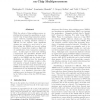Free Online Productivity Tools
i2Speak
i2Symbol
i2OCR
iTex2Img
iWeb2Print
iWeb2Shot
i2Type
iPdf2Split
iPdf2Merge
i2Bopomofo
i2Arabic
i2Style
i2Image
i2PDF
iLatex2Rtf
Sci2ools
VLDB
2005
ACM
2005
ACM
Optimistic Intra-Transaction Parallelism on Chip Multiprocessors
With the advent of chip multiprocessors, exploiting intra-transaction parallelism is an attractive way of improving transaction performance. However, exploiting intra-transaction parallelism in existing database systems is di’¼ācult, for two reasons: ’¼ürst, signi’¼ücant changes are required to avoid races or con’¼éicts within the DBMS, and second, adding threads to transactions requires a high level of sophistication from transaction programmers. In this paper we show how dividing a transaction into speculative threads solves both problemsŌĆöit minimizes the changes required to the DBMS, and the details of parallelization are hidden from the transaction programmer. Our technique requires a limited number of small, localized changes to a subset of the low-level data structures in the DBMS. Through this method of parallelizing transactions we can dramatically improve performance: on a simulated 4-processor chipmultiprocessor, we improve the response time by 36ŌĆō74% for three of the ’¼...
Database | Intra-transaction Parallelism | Transaction Performance | Transaction Programmer | VLDB 2005 |
| Added | 28 Jun 2010 |
| Updated | 28 Jun 2010 |
| Type | Conference |
| Year | 2005 |
| Where | VLDB |
| Authors | Christopher B. Colohan, Anastassia Ailamaki, J. Gregory Steffan, Todd C. Mowry |
Comments (0)

